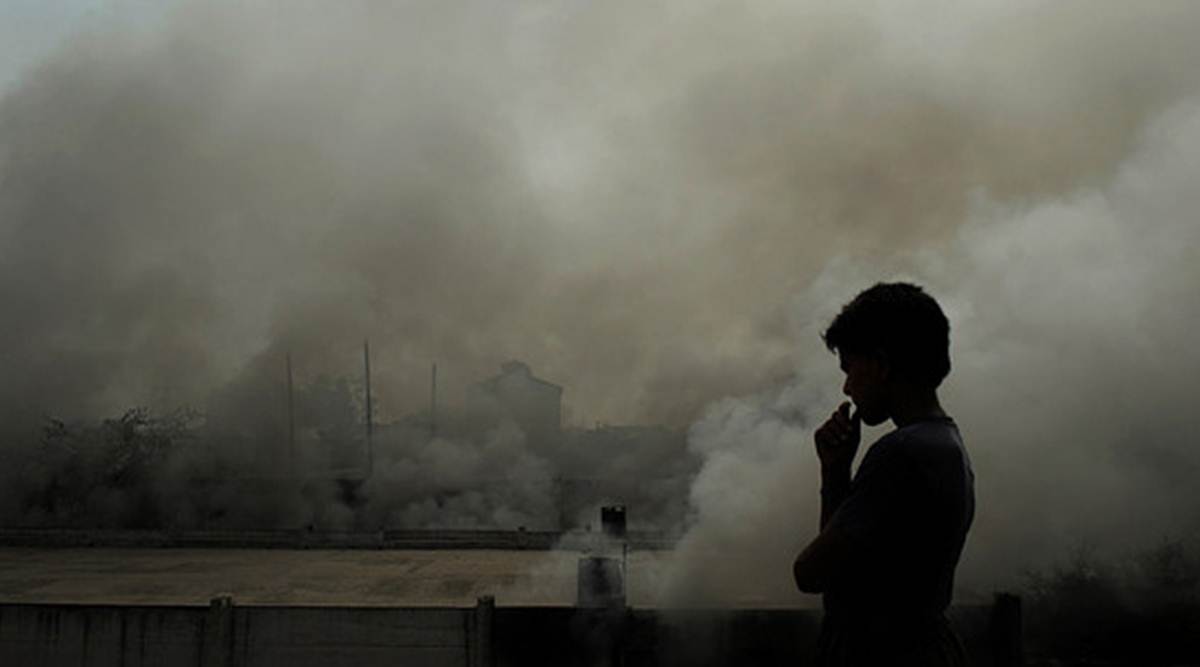 The Pune AIR Plan, developed by NRDC and partners, was launched at the webinar 'Air quality and public health in India: risks from climate change and Covid-19'. (Representational Photo)
The Pune AIR Plan, developed by NRDC and partners, was launched at the webinar 'Air quality and public health in India: risks from climate change and Covid-19'. (Representational Photo)AIR QUALITY continues to deteriorate further in Haryana, with more towns falling in the ‘severe’ category in terms of AQI (air quality index). Around two weeks ago, only Jind, Bahadurgarh, Charkhi Dadri and Dharuhera were in the ‘severe’ zone. Now, Bhiwani, Faridabad, Fatehabad, Gurugram, Hisar, Jind, Mewat, Manesar, Rohtak and Sonipat have been added to the list.
It is not clear whether this is happening because of stubble burning as the state agriculture and farmers’ welfare department has claimed that farm fires have dipped by 30 per cent this year in comparison to 2019.
An AQI beyond 401 is categorised as ‘severe’ as it affects healthy people and seriously impacts those with existing diseases.
AQI is considered ‘very poor’ when it is in the range of 301-400 as it can lead to respiratory illness on prolonged exposure. Kaithal, Kurukshetra, Panipat, Sirsa and Yamunanagar are in the ‘very poor’ category. Karnal (236) and Ambala (258) fall in the ‘poor’ category while Panchkula has entered the ‘moderate’ range. Two weeks ago, Panchkula was in the ‘satisfactory’ category with 96 AQI.
Sources in the government say the number of stubble burning cases can’t be compared fairly because of technical reasons. “Last year there was only one satellite to spot active fire locations, but this time one more satellite has been added to locate such fires. If we compare figures provided by one satellite then the number of active fire locations has decreased to 4,013 this year in comparison to 5,688 of 2019. But the newly-added satellite too has spotted 3,790 active fire locations, thus taking the number of such fire locations to 7,803 this year,” said an official.
Agriculture department Joint Director Jagminder Nain claimed the stubble burning cases have reduced by 30 per cent this year in comparison to 2019, while the same have increased by 50 per cent in Punjab. “This is based on numbers provided by the Indian Council for Agriculture Research. Many of the active fire locations as shown by the Haryana Space Applications Centre (HARSAC) satellites are not found on the ground. When our teams checked, around 40 per cent of the active fire locations, as shown by the satellites, were not found related to stubble burning. These may be related to brick kiln, solid waste management, factories or roadside fires,” said Nain.
“The cases of stubble burning have decreased because we have provided machines to farmers to process crop residue apart from continuing awareness campaigns. Though, a complete change in the mindset takes time,” he added.
FArmer leaders too have claimed the number of stubble burning cases have fallen in Haryana this year in comparison to 2019.
On the other hand, Haryana State Pollution Control Board Member Secretary S Narayanan told The Indian Express, “It’s not a single factor like stubble burning which is contributing to deterioration of AQI. There are a lot of factors for deterioration of AQI, particularly in areas falling in the close proximity to the national capital, like vehicular pollution, dust emission, road constructions and solid waste burnings. Furthermore, low temperature, low wind pressure and high moisture level are also contributing factors.”
Hot mix plant, stone crushers ordered to stay closed till Nov 17
Ahead of festive season, the Central Pollution Control Board (CPCB) has directed closure of hot mix plants and stone crushers in Delhi NCR till November 17.
Keeping in view the directions issued by CPCB, the Haryana State Pollution Control Board (HSPCB) Wednesday asked all deputy commissioners of the districts falling in NCR to take action accordingly.
“Frequency of mechanised cleaning of roads and water sprinkling to be increased, particularly on the road stretches with high dust generation potential. It shall be ensured that guidelines/SOPs for dust mitigation at construction sites are strictly adhered to. In case of violations, strict action should be taken against the violators like imposition of penalty/temporary stoppage of construction activities,” mentioned a communication issued by HPSCB while quoting directions issued by the CPCB.
It further said, “Immediate stringent actions to be taken for curbing stubble burning and any of the biomass burning activity should also be strictly checked and prevented.” According to the communication, CPCB has issued directions after concluding “the Air Quality Index (AQI) shall remain in very poor category and may result in severe category in coming days”.